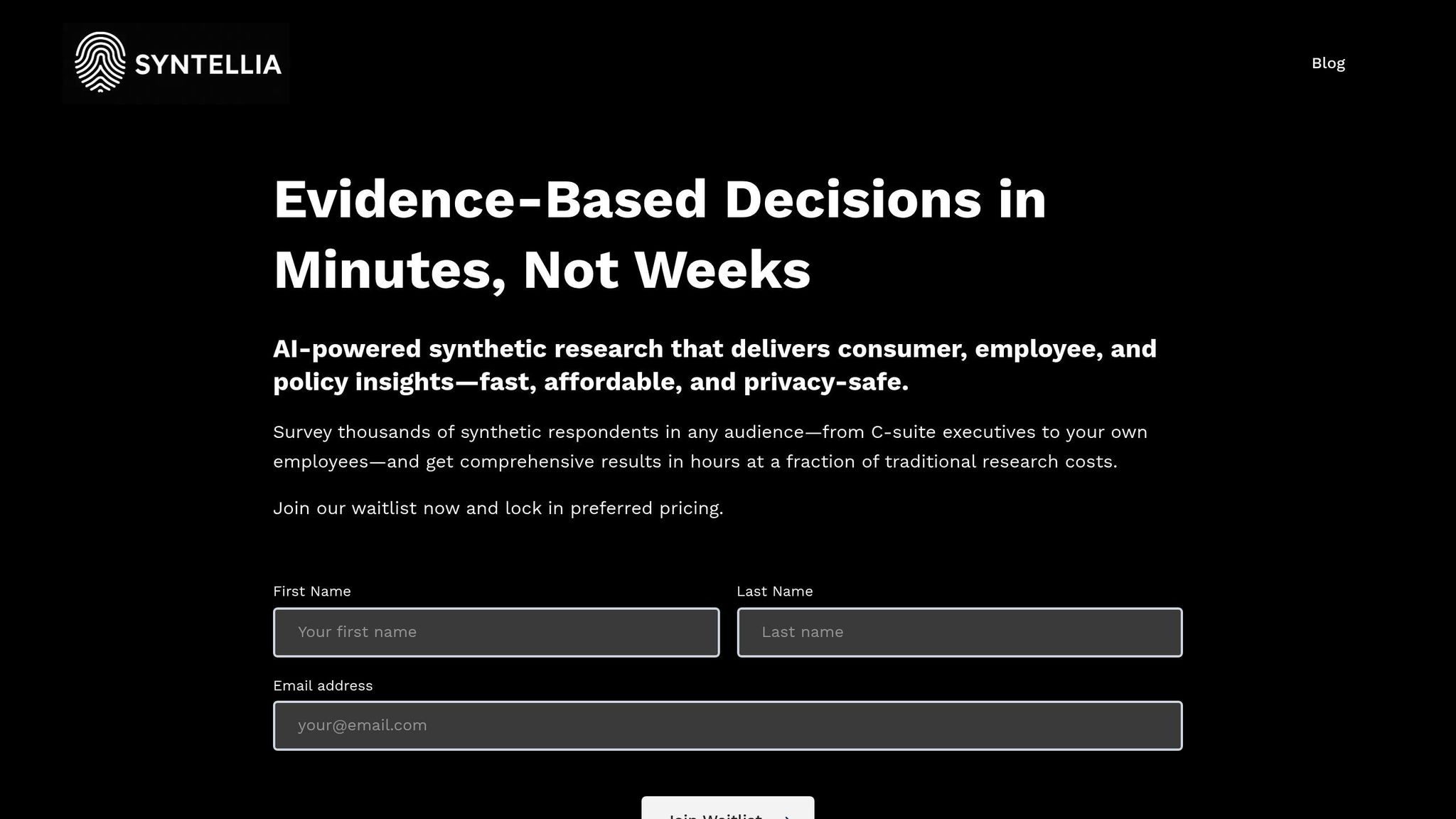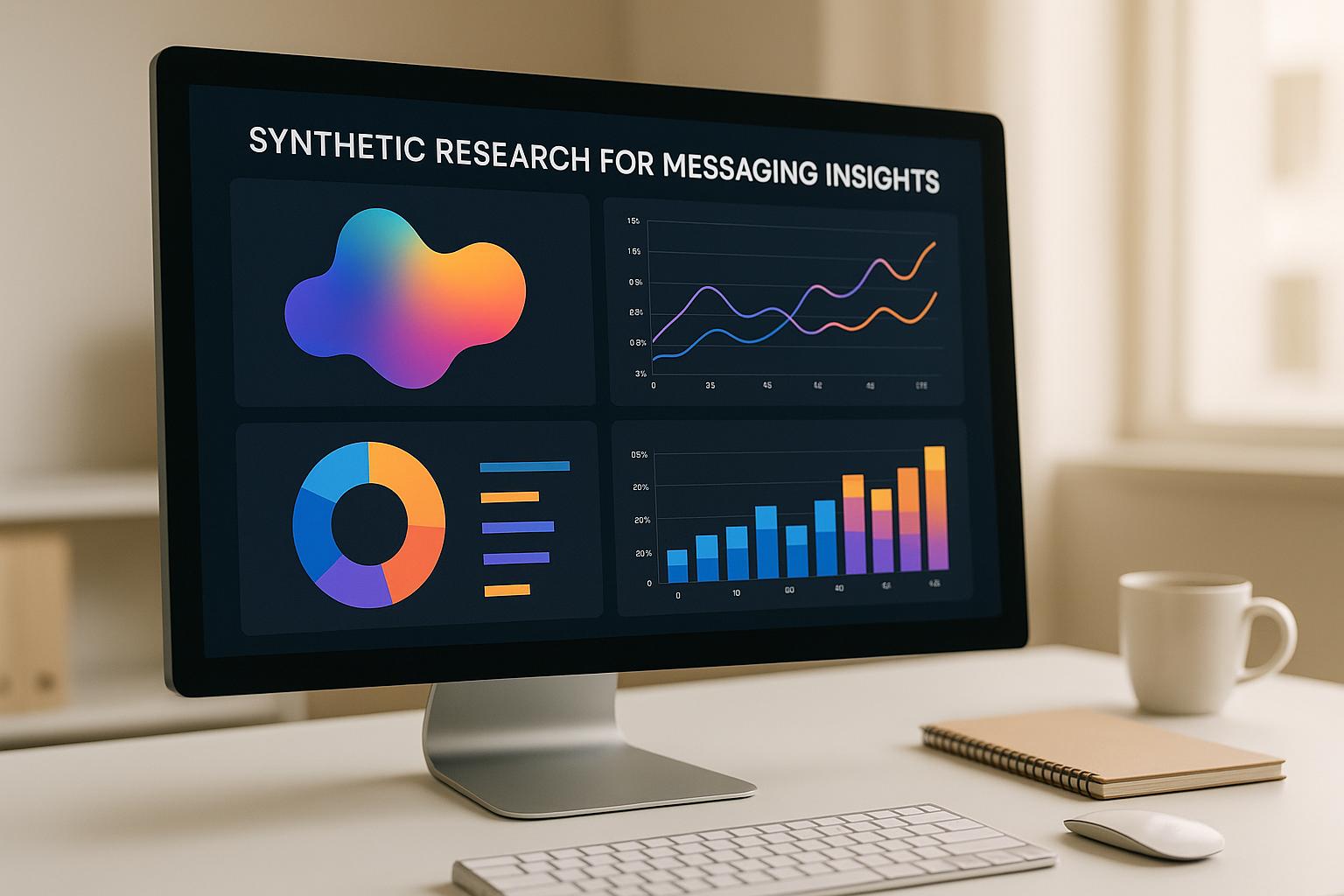When it comes to reducing bias in AI systems, choosing between synthetic data and real data depends on your priorities. Here’s the key takeaway:
- Synthetic data is artificially generated and can be designed to address bias by balancing representation, avoiding historical prejudices, and ensuring privacy compliance. It's faster and cheaper to create but may lack the complexity of real-world behavior.
- Real data is collected from actual events and interactions, offering genuine patterns and edge cases. However, it often mirrors existing societal biases and is expensive and time-intensive to gather.
Quick Overview:
- Use synthetic data for bias reduction, demographic balance, and privacy-sensitive scenarios.
- Use real data when authenticity and rare cases are critical.
- A hybrid approach often works best - start with synthetic data to address bias, then layer in real data for depth and accuracy.
Reducing bias isn’t a one-time fix. It requires a thoughtful mix of data types, regular audits, and careful validation.
Synthetic Data: Features and Bias Mitigation Methods
What is Synthetic Data?
Synthetic data refers to artificially created information that imitates the statistical patterns and relationships found in real-world datasets. Unlike actual data, it doesn’t include any personal or identifiable information, making it a privacy-friendly alternative.
The process of creating synthetic data relies on machine learning algorithms and statistical models to study the structures, distributions, and connections within existing datasets. Based on these insights, new data points are generated that maintain the characteristics of the original data while protecting sensitive details.
This type of data can be generated whenever needed, bypassing common hurdles like privacy concerns, incomplete data, or the need for participant consent. Advanced methods such as generative adversarial networks (GANs) and variational autoencoders are often used to produce highly realistic datasets. These methods also provide opportunities to address biases in a controlled manner, as discussed below.
How Synthetic Data Reduces Bias
Synthetic data offers several methods to tackle bias, thanks to its controlled and customizable creation process.
One major advantage is its ability to balance demographics. By intentionally generating data for underrepresented groups, organizations can ensure fair representation in datasets, which is crucial for building equitable AI systems.
It also addresses historical bias. Real-world data often reflects outdated or discriminatory practices embedded in historical records. Synthetic datasets can be designed to align with modern values and objectives, helping to move away from these entrenched biases.
Another benefit is the ability to test for bias in a controlled environment. Synthetic data allows organizations to simulate various scenarios and evaluate how their AI models respond, making it easier to identify and fix biases before they affect users.
Geographic and cultural representation is another area where synthetic data shines. Collecting diverse data samples from different locations can be expensive and time-consuming. Synthetic data simplifies this by enabling the creation of datasets that include balanced representation across regions, cultures, and socioeconomic groups.
Finally, synthetic data supports ongoing bias correction. When bias is detected in an AI system, new synthetic datasets can be quickly generated to address the issue without the need for costly and time-intensive data collection efforts.
Challenges of Using Synthetic Data
While synthetic data offers promising solutions, it’s not without its challenges. One of the biggest hurdles is maintaining statistical accuracy while capturing the intricacies of human behavior. Striking this balance is complex and requires careful attention.
Another concern is the risk of hidden bias transfer. If the original data used to train the synthetic data generation models contains biases, those biases may unintentionally carry over into the synthetic datasets, potentially giving a false impression of fairness.
Validation is another critical issue. Ensuring that synthetic datasets accurately represent the intended populations is essential to avoid overconfidence in AI systems trained on this data.
Edge cases also pose a significant problem. Real-world datasets naturally include rare but impactful scenarios that are crucial for robust AI performance. Synthetic data may miss these edge cases or fail to represent them adequately, leading to systems that perform well in controlled tests but falter in real-world conditions.
Lastly, regulatory acceptance remains a challenge. Despite its privacy advantages, synthetic data may face scrutiny from industries or regulatory bodies that require proof of its reliability and ability to represent real-world populations accurately, especially in high-stakes applications.
Real Data: Strengths and Limitations for Bias Mitigation
Strengths of Real Data
Real-world data offers a level of authenticity that synthetic data simply can’t replicate. When organizations rely on data derived from actual human interactions, behaviors, and events, they’re capturing the intricate complexity of how people make decisions and how society functions. This is especially crucial for AI systems tasked with interpreting and responding to real-world behaviors. Using data rooted in real experiences ensures relevance and statistical accuracy, which are key to identifying subtle biases in intricate scenarios.
One of the standout advantages of real data is its depth. Real datasets inherently include outliers, edge cases, and diverse patterns that reflect the true makeup of a population. This level of detail is invaluable in sensitive fields like healthcare and finance, where understanding rare but critical cases can be the difference between an AI system that helps and one that harms.
Another strength lies in how real data unveils the complex interplay between variables. By analyzing how different factors influence outcomes, real data provides a clearer picture of the dependencies and correlations that emerge from genuine human interactions and societal dynamics. This makes it an essential tool for understanding how bias can develop through interconnected variables and social structures.
Experts also emphasize the unmatched value of real data in high-stakes applications. The United Nations University highlights this sentiment with a clear stance:
"no synthetic data is better than data from the physical world."
They further explain:
"Anything else, like synthetic data of cancerous and healthy cells, makes the AI detection system less reliable."
In scenarios requiring precision and reliability, real-world data remains indispensable.
Synthetic vs. Real Data: Direct Comparison
Comparison Table of Key Factors
Choosing between synthetic and real data means evaluating how each performs in critical areas. Here's a side-by-side look at key factors that influence bias reduction and effectiveness in AI systems:
| Factor | Synthetic Data | Real Data |
|---|---|---|
| Bias Reduction | High - Can be designed to remove historical biases and ensure balanced representation | Moderate - Reflects actual patterns but may reinforce existing societal biases |
| Cost | Low - Created computationally without collection expenses | High - Involves significant collection, cleaning, and processing costs |
| Speed & Efficiency | Very High - Can be generated instantly and at scale | Low - Requires time-intensive collection and preparation |
| Privacy Compliance | Excellent - No personal data exposure; inherently GDPR/CCPA compliant | Challenging - Needs anonymization, consent handling, and strict regulatory alignment |
| Data Quality Control | High - Allows precise control over characteristics and distribution | Variable - Prone to errors, missing data, and inconsistencies |
| Regulatory Acceptance | Evolving - Gaining traction but still under scrutiny in certain sectors | Established - Widely accepted for compliance purposes |
| Scalability | Unlimited - Can produce large datasets on demand | Limited - Restricted by collection capacity and costs |
| Real-world Accuracy | Moderate - May lack nuanced real-world patterns and edge cases | High - Captures genuine human behavior and societal dynamics |
Synthetic data shines in controlled environments, especially for reducing biases, while real data captures the intricacies of human behavior. Deciding between the two depends on the specific needs of your application.
When to Use Synthetic or Real Data
The choice between synthetic and real data hinges on your goals and constraints. Here's how to align your approach to your priorities:
Choose synthetic data when reducing bias and ensuring demographic balance are top priorities, especially if you're working with limited time or budget. Synthetic data is particularly useful for training models that require balanced representation across demographic groups or when dealing with sensitive information that demands strict privacy protection. It's also a go-to for prototyping and testing bias mitigation strategies due to its cost-effectiveness and scalability.
Industries like financial services, healthcare diagnostics, or hiring algorithms often benefit from synthetic data. For instance, it can help neutralize bias in hiring algorithms by ensuring equal representation across demographics.
Opt for real data when authenticity, subtle social dynamics, and critical edge cases are essential. Real data is indispensable for applications where missing edge cases or failing to understand social nuances could lead to serious consequences. It's also often required by regulatory bodies that mandate real-world testing to validate AI systems.
High-stakes scenarios like medical diagnostics, autonomous driving, and fraud detection rely on real data to account for unpredictable events and complex interactions. These edge cases often hold the key to making AI systems reliable and effective.
Consider a hybrid approach when both bias reduction and real-world accuracy are crucial. Many organizations begin with synthetic data to establish a bias-free foundation and later incorporate real data to capture authenticity and address edge cases. This strategy balances ethical considerations with the need to handle real-world complexities.
Ultimately, the decision comes down to whether your primary goal is removing biases (favor synthetic data) or capturing real-world complexity (favor real data). Your choice will directly shape the fairness and precision of your AI system.
sbb-itb-2b2bc16
Using Synthetic Data Platforms for Bias Mitigation
Introducing Syntellia: A Synthetic Data Solution

Syntellia is transforming the way organizations handle bias in datasets by leveraging synthetic data. This platform generates simulated respondents that provide insights into consumer behavior, employee trends, and policy impacts - all with 90% behavioral accuracy. Unlike traditional methods, it eliminates privacy risks and the biases often baked into standard data collection practices.
Traditional research methods can cost anywhere from $50K to $250K and take 6–12 weeks to complete. These time and budget constraints frequently lead to smaller, less diverse samples that fail to capture the full spectrum of demographic representation needed for unbiased AI training. Syntellia flips this model on its head. By using synthetic data, it cuts costs by 90% and delivers results in as little as 30–60 minutes. This speed opens the door to extensive bias testing and rapid iteration of AI models.
The platform also provides unlimited access to diverse audiences, whether you're targeting executives, niche professionals, or other specialized groups. This eliminates the recruitment challenges that often lead to skewed datasets. Researchers can adjust questions and scenarios in real time, enabling them to pinpoint and address biases in their methodologies. This adaptability ensures ongoing improvements in demographic representation.
Another standout feature of Syntellia's approach is its ability to sidestep privacy risks. Since no real individuals are involved in the research process, organizations face zero privacy risks and are inherently compliant with regulations like GDPR and CCPA. This removes the need for complex consent processes or data anonymization, which can unintentionally introduce bias when certain groups opt out at higher rates.
With these capabilities, Syntellia lays the groundwork for more balanced and ethical AI systems.
Best Practices for Synthetic Data Integration
To make the most of synthetic data, it’s essential to follow a structured approach that prioritizes bias reduction without compromising the integrity of your research. Here’s how to get started:
- Audit your current datasets: Begin by identifying areas where bias exists. Look for underrepresented groups or skewed distributions in your data.
- Balance demographics: Synthetic data platforms can fill gaps in representation, creating datasets that reflect a wide range of demographic factors such as age, gender, ethnicity, and income. This ensures your AI models are trained on data that mirrors real-world diversity.
- Validate with real-world samples: Run parallel tests using small real-world datasets to compare results. This step helps identify any differences between synthetic and real data, allowing for adjustments to improve accuracy.
- Iterate and refine: Use synthetic data to test multiple variations of survey questions or scenarios. This helps uncover subtle biases in question phrasing or response options that may skew results.
- Combine synthetic and real data: Use synthetic data as a foundation for balanced representation, then supplement it with targeted real-world data to capture edge cases and nuanced behaviors. This hybrid approach leverages the strengths of both data types.
- Monitor regularly: Conduct quarterly reviews of your synthetic data models to ensure they stay aligned with evolving societal attitudes and behaviors.
- Document your efforts: Keep detailed records of your bias mitigation strategies, including the synthetic data interventions used, their impact on fairness, and adjustments made during validation. This documentation is crucial for regulatory compliance and demonstrating accountability to stakeholders.
Conclusion: Key Takeaways for Bias Reduction in AI
When it comes to reducing bias in AI, the choice between synthetic and real data isn’t about picking a clear winner - it’s about knowing when to use each approach. Real data reflects authentic human behavior and decision-making, capturing the complexities of the real world. But it often carries its own baggage, like ingrained biases, privacy concerns, and gaps in representation that can lead to unfair outcomes.
On the other hand, synthetic data steps in as a practical alternative. It minimizes privacy risks and opens the door to a wider range of demographic representation. Platforms like Syntellia demonstrate how synthetic data can be a cost-efficient option, allowing for extensive bias testing and quicker iterations on AI models.
The best results often come from blending the two. Start with synthetic data to ensure balanced representation and to test for bias. Then, layer in carefully selected real-world data to address edge cases and add depth. This hybrid approach combines the diversity and cost advantages of synthetic data with the richness and authenticity of real data, creating a more robust foundation for fair AI systems.
Reducing bias isn’t a one-and-done task - it’s an ongoing process. Regularly auditing datasets, reviewing synthetic data models, and documenting bias mitigation efforts are all critical steps. The goal? To build datasets that are fair and representative, ensuring AI systems serve all users equitably.
As AI increasingly influences decisions in areas like hiring, lending, healthcare, and criminal justice, the pressure to reduce bias is only growing. Organizations that tackle these challenges head-on with smart data strategies will not only create more trustworthy AI systems but also avoid the reputational and legal pitfalls of biased algorithms.
FAQs
How does synthetic data help address biases in real-world datasets?
Synthetic data offers a powerful way to address biases by enabling the creation of datasets that are more balanced and inclusive. Unlike real-world data, which often mirrors historical inequalities and systemic biases, synthetic data can be designed to reflect diverse scenarios and include underrepresented groups.
By simulating a broader range of possibilities, synthetic data helps train AI models on datasets that are fairer and more representative. This approach improves decision-making and minimizes the risk of reinforcing existing biases.
What challenges might arise when using synthetic data to train AI models?
Using synthetic data for AI training comes with its own set of challenges. A major concern is that any biases in the real-world data used to create synthetic datasets can creep into the final product, leading to skewed or unreliable results. On top of that, synthetic data often struggles to capture the full complexity and variety of real-world data, which means it might miss outliers or subtle patterns that could be crucial for accurate training.
Another hurdle is the need for thorough validation to confirm that the synthetic data aligns with the intended scenarios. This process can be time-intensive and requires significant effort to get right. There's also the issue of trust - stakeholders may be hesitant to rely on artificial data, particularly if transparency around how it was generated and validated isn't clearly communicated. Addressing these challenges requires careful planning, rigorous validation, and open communication to build confidence in the use of synthetic data.
When is it most effective to combine synthetic and real data in AI systems?
Using a combination of synthetic and real data can be a smart way to balance accuracy, scalability, and privacy. This approach shines in situations where collecting real-world data is challenging - whether due to limited availability, sensitivity, or high costs. By blending the realism of actual data with the adaptability of synthetic data, AI systems can better capture complex patterns, tackle biases, and stay in line with privacy rules. This strategy is especially valuable in fields like healthcare, finance, and policy research, where high-quality data and ethical standards are essential.


